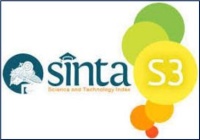Analisis Filogenetik Apis dorsata (Fabricius 1793) Bedasarkan Gen Chytochrome Oxidaxe I (COI)
Abstract
Keywords
Full Text:
PDFReferences
Ali, H., Iqbal, J., Raweh, H. S., & Alqarni, A. S. (2021). Proboscis behavioral response of four honey bee Apis species towards different concentrations of sucrose, glucose, and fructose. Saudi Journal of Biological Sciences, 28(6), 3275-3283. https://doi.org/10.1016/j.sjbs.2021.02.069
Baskaran, M. (2016). Variations in the CO-I and CO-II regions of mtDNA of the Indian honeybee Apis cerana indica (Farb.) in Tamil Nadu. Bulletin of Pure & Applied Sciences-Zoology, 35(1), 21-29. https://doi.org/10.5958/2320-3188.2016.00004.8
Bovo, S., Utzeri, V. J., Ribani, A., Cabbri, R., & Fontanesi, L. (2020). Shotgun sequencing of honey DNA can describe honey bee derived environmental signatures and the honey bee hologenome complexity. Scientific Reports, 10(1), 1–17. https://doi.org/10.1038/s41598-020-66127-1
Choiriyah, C. H. U. M. A. I. D. A. T. U. L. (2020). Optimasi amplifikasi ITS rDNA khamir menggunakan metode PCR yang diisolasi dari sarang lebah madu raksasa (Apis dorsata). UINSA Digital Library. http://digilib.uinsa.ac.id/id/eprint/42973
Ferdyan, R., Sumarmin, R., & Putri, D. H. (2021). Perbandingan sumber pakan dan strategi pemberian pakan Apis cerana dengan Apidae lainnya: A review. Bio-Lectura: Jurnal Pendidikan Biologi, 8(1), 37-44. https://doi.org/10.31849/bl.v8i1.6484
Hasam, S., Qarizada, D., & Azizi, M. (2020). A review: Honey and its nutritional composition. Asian Journal of Research in Biochemistry, 7(3), 34–43. https://doi.org/10.9734/ajrb/2020/v7i330142
Iwasaki, J. M., & Hogendoorn, K. (2021). How protection of honey bees can help and hinder bee conservation. Current Opinion in Insect Science, 46, 112–118.
Lamerkabel, J. S. A., Rumthe, R. Y., & Sarkol, M. E. (2023). Species diversity and nesting descriptions of stingless bees (Apidae; Meliponini) on Ambon Island. Jurnal Budidaya Pertanian, 19(1), 79–86. https://doi.org/10.30598/jbdp.2023.19.1.79
Li, H. Y., Luo, A. C., Hao, Y. J., Dou, F. Y., Kou, R. M., Orr, M. C., Zhu, C. D., & Huang, D. Y. (2021). Comparison of the pollination efficiency of Apis cerana with wild bees in oil-seed camellia fields. Basic and Applied Ecology, 56, 250–258. https://doi.org/10.1016/j.baae.2021.08.005
Liu, F., Shi, T., Yin, W., Su, X., Qi, L., Huang, Z. Y., ... & Yu, L. (2017). The microRNA ame-miR-279a regulates sucrose responsiveness of forager honey bees (Apis mellifera). Insect Biochemistry and Molecular Biology, 90, 34-42. https://doi.org/10.1016/j.ibmb.2017.09.008
Mamuaya, T., Samuel, M. Y., & Christine, A. C. (2024). Morphology, morphometry and analysis of the CO1 gene in silico Apis dorsata binghami from Southeast Minahasa. Jurnal Pendidikan Tambusai, 8, 8777–8785. https://doi.org/10.31004/jptam.v8i1.13716
Moradi, H., Khanahmad, H., Hosseini, M., & Rahimmanesh, I. (2017). SmtDNA: A Geant4-DNA user application for evaluating radiation-induced damage in supercoiled mitochondrial DNA. Journal of Biomedical Physics & Engineering, 1(6), 1-12.
Nabilla, M. (2024). Analisis jurnal variasi genetik makhluk hidup eukariotik. Jurnal Multidisiplin Ilmu Akademik, 1(3), 861-871. https://doi.org/10.61722/jmia.v1i3.1798
Niode, N. J., Adji, A., Rimbing, J., Tulung, M., Takahashi, J. I., Idroes, R., & Tallei, T. E. (2023, May). Genetic diversity analysis of Apis dorsata (Hymenoptera: Apidae) based on cytochrome C oxidase subunit I gene sequences. AIP Conference Proceedings, 2480(1). AIP Publishing. https://doi.org/10.1063/5.0103887
Nufus, L. S., Andayani, D., & Pahmi, K. (2023). Isolasi asam nukleat dari tanaman brokoli (Brassica oleracea L.). Jurnal Ilmu Kesehatan dan Farmasi, 11(2), 53-55. https://doi.org/10.51673/jikf.v11i2.2038
Pangsuma, N., & Hidayat, T. (2023). The urgency of understanding taxonomy in learning biology. BIODIK, 9(4), 95-110. https://doi.org/10.22437/biodik.v9i4.31092
Parker, C., Bernaola, L., Lee, B. W., Elmquist, D., Cohen, A., Marshall, A., ... & Tussey, D. (2019). Entomology in the 21st century: Tackling insect invasions, promoting advancements in technology, and using effective science communication—2018 student debates. Journal of Insect Science, 19(4), 4. https://doi.org/10.1093/jisesa/iez069
Semuel, M. Y., Wurarah, M., & Tuegeh, R. S. (2022). Antagonistic and antibacterial activity of Staphylococcus aureus and isolates of oral bacteria from the endogenous fungus Apis dorsata binghami nest. Jurnal Pembelajaran dan Biologi Nukleus (JPBN), 8(2), 273-283. https://doi.org/10.36987/jpbn.v8i2.2739
Shakya, M., Ahmed, S. A., Davenport, K. W., Flynn, M. C., Lo, C. C., & Chain, P. S. G. (2020). Standardized phylogenetic and molecular evolutionary analysis applied to species across the microbial tree of life. Scientific Reports, 10(1), 1–15. https://doi.org/10.1038/s41598-020-58356-1
Sopaladawan, P. N., Buala, S., & Pramual, P. (2024). Genetic diversity, genetic structure, and demographic history of giant honeybee Apis dorsata Fabricius, 1793 (Hymenoptera: Apidae) in Thailand. Tropical Natural History, 24, 230-238. https://doi.org/10.58837/tnh.24.1.264542
Subari, A., Razak, A., & Sumarmin, R. (2021). Phylogenetic analysis of Rasbora spp. based on the mitochondrial DNA COI gene in Harapan Forest. Jurnal Biologi Tropis, 21(1), 89–94. https://doi.org/10.29303/JBT.V21I1.2351
Zhang, H., & Bu, W. (2022). Exploring large-scale patterns of genetic variation in the COI gene among Insecta: Implications for DNA barcoding and threshold-based species delimitation studies. Insects, 13(5), 425. https://doi.org/10.3390/insects13050425
DOI: https://doi.org/10.33394/bioscientist.v13i1.14899
Refbacks
- There are currently no refbacks.

This work is licensed under a Creative Commons Attribution-ShareAlike 4.0 International License.

Bioscientist : Jurnal Ilmiah Biologi is licensed under a Creative Commons Attribution-ShareAlike 4.0 International License
Editorial Address: Pemuda Street No. 59A, Catur Building Floor I, Mataram City, West Nusa Tenggara Province, Indonesia











